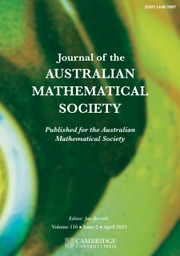Crossref Citations
This article has been cited by the following publications. This list is generated based on data provided by Crossref.
Ravenstein, Tony van
Winley, Graham
and
Tognetti, Keith
1990.
Characteristics and the Three Gap Theorem.
The Fibonacci Quarterly,
Vol. 28,
Issue. 3,
p.
204.
Tognetti, Keith
Winley, Graham
and
van Ravenstein, Tony
1990.
Applications of Fibonacci Numbers.
p.
325.
Siegel, Ralph M.
Tresser, Charles
and
Zettler, George
1992.
A decoding problem in dynamics and in number theory.
Chaos: An Interdisciplinary Journal of Nonlinear Science,
Vol. 2,
Issue. 4,
p.
473.
Komatsu, Takao
1995.
Results on fractional parts of linear functions of n and applications to Beatty sequences.
Bulletin of the Australian Mathematical Society,
Vol. 52,
Issue. 2,
p.
349.
Komatsu, Takao
1995.
The fractional part of nθ+ø and Beatty sequences.
Journal de théorie des nombres de Bordeaux,
Vol. 7,
Issue. 2,
p.
387.
Anderson, Peter G.
1998.
Applications of Fibonacci Numbers.
p.
9.
Mayero, Micaela
2000.
Types for Proofs and Programs.
Vol. 1956,
Issue. ,
p.
162.
Justin, Jacques
and
Pirillo, Giuseppe
2001.
Fractional powers in Sturmian words.
Theoretical Computer Science,
Vol. 255,
Issue. 1-2,
p.
363.
Komatsu, Takao
2001.
On Palindromic Sequences from Irrational Numbers.
The Fibonacci Quarterly,
Vol. 39,
Issue. 1,
p.
66.
Komatsu, Takao
2003.
The Interval Associated with a Fibonacci Number.
The Fibonacci Quarterly,
Vol. 41,
Issue. 1,
p.
3.
Larcher, G.
Leobacher, G.
and
Scheicher, K.
2003.
On the tractability of the Brownian Bridge algorithm.
Journal of Complexity,
Vol. 19,
Issue. 4,
p.
511.
Arias-de-Reyna, E.
and
Acha-Catalina, J.I.
2005.
Synchronization of UWB signals in the dense multipath channel based on the golden section.
p.
474.
Chuan, Wai-Fong
2005.
Factors of characteristic words of irrational numbers.
Theoretical Computer Science,
Vol. 337,
Issue. 1-3,
p.
169.
Trott, Michael
2006.
The Mathematica GuideBook for Numerics.
p.
968.
Arias-de-Reyna, Eva
and
Acha-Catalina, José I.
2007.
Coarse synchronization of UWB signals in the dense multipath channel based on the golden section.
Journal of the Franklin Institute,
Vol. 344,
Issue. 2,
p.
128.
Chevallier, Nicolas
2007.
Cyclic Groups and the Three Distance Theorem.
Canadian Journal of Mathematics,
Vol. 59,
Issue. 3,
p.
503.
Tognetti, Keith
2008.
On self-matching within integer part sequences.
Discrete Mathematics,
Vol. 308,
Issue. 24,
p.
6539.
Kuhlmann, Sally
2008.
Geodesic knots in closed hyperbolic 3-manifolds.
Geometriae Dedicata,
Vol. 131,
Issue. 1,
p.
181.
del Pilar Romero de la Rosa, María
2009.
Regular orbits and positive directions.
Positivity,
Vol. 13,
Issue. 4,
p.
631.
Arias-de-Reyna, E.
and
Acha-Catalina, J.I.
2009.
Blind and Efficient Serial Search Strategy for Ultrawideband Signal Initial Acquisition.
IEEE Transactions on Vehicular Technology,
Vol. 58,
Issue. 6,
p.
3053.

